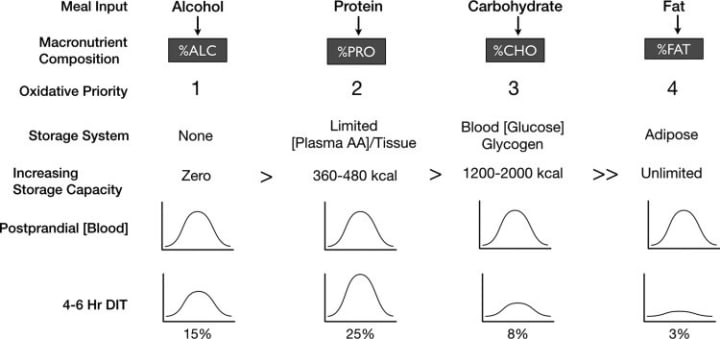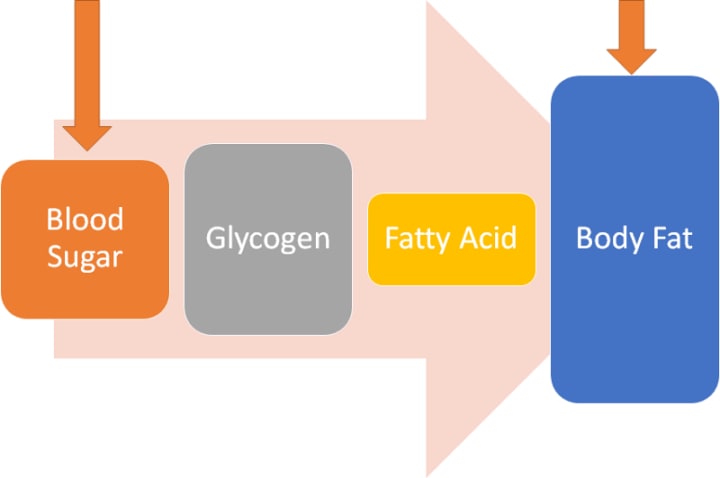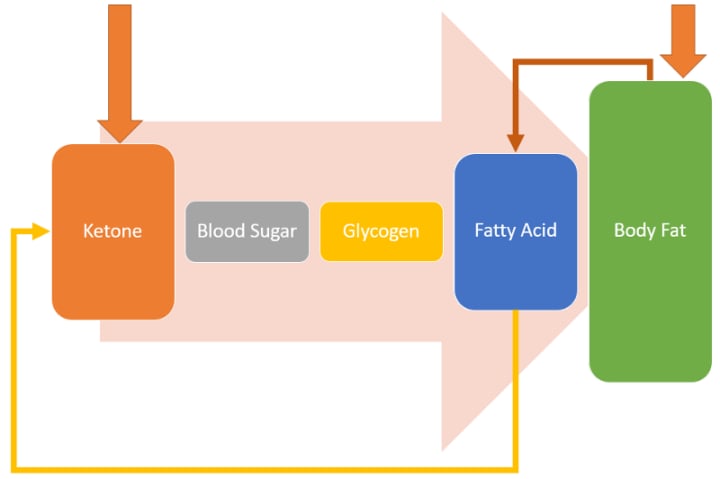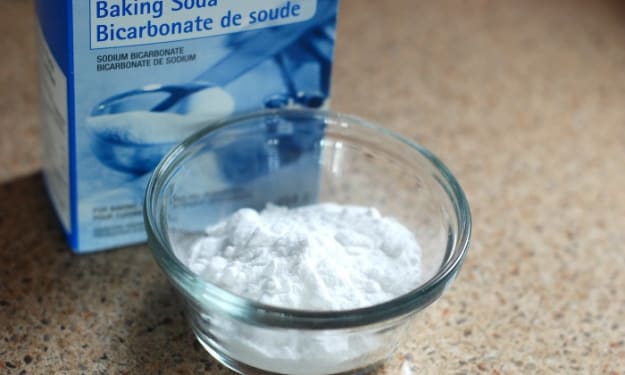
Introduction
“You should eat this.” “You cannot eat this. This will make you fat!” If you ask about fat loss, people would suggest things that work for them or think it is good for fat loss.
The Ketogenic Diet is so popular now. But before that, there are the Low-Fat Diet, the Paleo Diet. There is science behind all that, and it is not easy for everyone. Following a diet also require discipline. That is why not everyone can keep up.
We all familiar with the concept of Calories in fat burning. What we can learn from it is basically how much we should eat, and that’s all. This time I want to introduce one rule. The one that is underneath most diets. It is the Oxidative Priority, and how this is related to fat loss.
What is Oxidative Priority?
Not all fuels are burned equally. Oxidative Priority is the order of fuels that the body prefers to burn and how it affects metabolic activities. Our body stores different fuel (ketones, fat, glucose, protein, and alcohol).
That means, in simpler English, some fuels are burned first, and some are stored first. In general, alcohol has a priority, while fat is the last.

We can use this priority to explain why Ethanol is toxic to our bodies. As indicated in the study, Ethanol causes acute inhibition of carbohydrate, fat, and protein oxidation and insulin resistance:
Ethanol decreased total body fat oxidation by 79% and protein oxidation by 39% and almost completely abolished the 249% rise in carbohydrate (CHO) oxidation seen in controls after glucose infusion.
Ethanol is one kind of alcohol that has the first oxidative priority. An abundance of it would inhibit the oxidation of other fuels and further impact the metabolism. With different sources available to your body, the order of fuels consumption is as below:
- Alcohol
- Blood Sugar
- Glycogen stored in liver and muscle
- Free Fatty Acids in your blood
- Body Fat
A message for people who want to lose fat: body fat has the lowest priority, as you can see. To use body fat as fuel, excess fatty acid and sugar (glucose) in the blood are required to deplete first.
How oxidative Priority (OP) affects you?
With this concept in mind, you can now understand what kind of food sources are easier to be used and which one would be stored. For example, our body cannot store much ketones or alcohol, as they have the highest priority and would be used once available.
In the following, let me apply it in several diets to explain more. One key element is not mentioned in the first two scenarios to simplify the equation — protein. Eating sufficient protein each day is crucial for good health and longevity, but that should be discussed separately. In short, protein is a macronutrient for all parts of our health.
Application 1# —Modern Western Diet

According to the article, Modern Western Diet is characterized as a high dietary intake of saturated fats and sucrose and low fiber intake. Refined sugar and fats are the main ingredients of this type of diet.
From the perspective of OP, the high sugar content inhibits access to fuel sources with lower priority. The high-fat content then goes into storage instead of fuel. That is the basis of why eating Mcdonalds every day is bad for losing weight even if you only eat once a day.
The low nutrient density, hyper-palatable foods fill our blood sugar and body fats, and finally, all storage containers become overfull. This leads to metabolic syndromes, such as diabetes and Inflamm-aging.
Further promotion of the Modern Western Diet problem is refined sugar and fats (Trans-fats and unsaturated fats) promote inflammation. That creates a vicious cycle of prolonged metabolic diseases.
Application 2# — Ketogenic Diet
While Ketosis can increase the rate of fat oxidation, it doesn’t necessarily burn more calories. Energy production and physical activity are the main sources of calories burning.

With a limited supply of sugar, glycogen starts to deplete to balance our blood sugar levels. This progress will further promote gluconeogenesis with the usage of body fat and fatty acid. Being in Ketosis alters the OP in our body. Ketone adaptation promotes body fat and ketone bodies as fuels instead of glucose (Burning fat > burning glucose). According to the study:
Ketogenesis is a metabolic pathway that produces ketone bodies, which provide an alternative form of energy for the body.
In a state of ketosis, ketone body production is increased when there are decreased carbohydrates or increased fatty acids.
Ketogenesis produces acetone, acetoacetate, and beta-hydroxybutyrate (ketone bodies) molecules by breaking down fatty acids.
From the perspective of OP, ketone bodies have a higher priority than sugar, generated from fatty acids by the ketogenesis process. This is why the oxidation of fat increases during ketosis.
Eating a high-fat diet in the presence of others with a higher OP may result in higher fat storage due to decreased fat oxidation, such as alcohol or sugar. The body will shift back to burning the other fuels instead of fat due to fat going into storage. A mixed diet with high fat and high sugar is not recommended. That is why the ketogenic diet emphasizes the importance of low-carb, high-fat.
One warning is excessive fat intake as different satiety with fat and sugar. With the over intake of fat, which on the one hand, can promote fat oxidation, but the excessive fat intake would go into the storage also, so keeping a regulated amount of food intake is also important.
Application 3# — Paleo Diet
Paleo Diet consists of adequate protein, low fat, and low carb. With low fat and sugar in the diet, it is easier for the body to tap into the stored energy, stored blood sugar, glycogen, and, ultimately, body fat. The main calorie contributor to a Paleo Diet — protein also has several extra benefits.
Higher protein diets tend to promote fat loss since our body “wastes” more energy on digestion. Since protein has the highest thermic effect on food.
The thermic effect of food (TEF), defined as the increase in metabolic rate after ingestion of a meal.
Protein also provides better satiety that fills you up faster. The increase in protein intake also increases muscle growth that leads to a higher metabolic rate.
Application 4# — Weight Loss
The first thing to consider for weight loss is not low fat, but low carb as carb has a higher priority than fat. Less sugar from food sources would then promote access to other fuels from the body. The second thing to consider is ketosis.

Being Keto-adapted could help the body to shift from sugar-burning mode to “fat-burning” mode. High protein intake could be the right way, too, as protein has the highest thermic effect and a higher OP than Carb and Fat. This can make sure the digestion promotes higher metabolism.
To further promote fat burning, it would be a great option to consider intermittent fasting to ensure the absence of external energy sources so that inner fuels could be used. Intermittent fasting also increases autophagy that can promote lipolysis.
Takeaways
Thank you for reading. This time I shared the Concept of Oxidative Priority. I hope this could be the one and only rules that people hate to understand what diets are good or bad and what to eat and what not to.
OP, on the other hand, can apply to diets or food choices in a general way. I also mentioned the applications of OP in 4 different ways:
- Application 1# -Modern Western Diet
- Application 2# — Ketogenic Diet
- Application 3# — Paleo Diet
- Application 4# — Weight Loss
Some DON’T for optimal weight loss from Oxidative Priority (OP)
• Don’t drink alcohol and eat at the same time as alcohol inhibits the oxidation of other fuels.
• Don’t combine carbs and fats, which would suppress fat oxidations.
• Don’t eat all the time. Give the body more time to use inner fuels.
If you like this article, please share it with people who may like it too! Thank you.
Happy reading and learning about OP!
About the Creator
Z3n Ch4n
Interested in Infosec & Biohacking. Security Consultant. Love reading and running.
hackernoon.com/u/z3nch4n






Comments
There are no comments for this story
Be the first to respond and start the conversation.